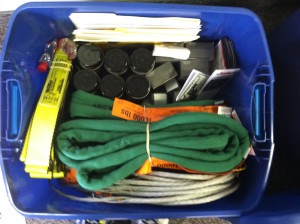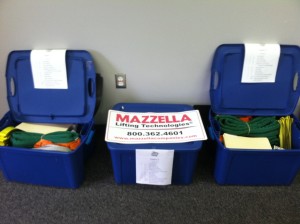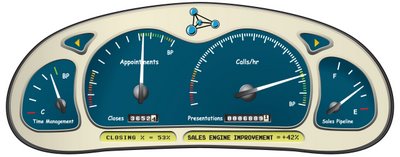What you need in the field for a successful Sales Blitz!
In a Sales Blitz every door is an opportunity and if your salespeople aren’t properly equipped they can miss it.
Sales….. Like Lightning
“How can we achieve a near-term sales increase combined with long-term sustainable revenue growth?”
This is a question that hangs in the air during virtually every conversation between owners, C-Level and Sales Management. One of the tried and true methods to achieve at least half of the equation is to conduct a sales blitz. The trick is how do you morph a temporary sales boost into the “new normal”?
A sales blitz is designed to fulfill the urgent need of increasing sales pipelines immediately. And most sales organizations know the basic “flavors” of blitzes with formats being designed for, at best, impermanent returns. I say both goals of an immediate sales bump and establishing the “new normal” are possible.
It’s a challenge melding lead generation, continual development training and motivational sales meetings, I grant you, but if you run a Blitz using this system be prepared for a revenue growing, “sales climate changing” event.
 S.E.T.U.P. your team for success
S.E.T.U.P. your team for success
Strategy
This step should start minimally 60 days before the blitz. Map out EVERY detail from the initial touch, phone dial, live visit, all follow-up and ongoing relationship builders and more. At the planning meeting ask these questions:
-
What market/area are you attempt to penetrate?
-
What is the goal(s) of the blitz? Short term, Mid Term and Long Term?
-
How can you warm up the market/area you will be blitzing?
-
What will you use to warm them up? What frequency? What platform?
-
What products fit/are most desired by this market?
-
What vendors should you team with?
-
What should your teams have with them? Brochures? Giveaways?
-
What will be the competition’s reaction?
These questions are a great starting point but you have to go deeper yet. We all know long term sales success is about the grind. Doing the little things everyday that build best practice habits that ultimately pay off. It’s the same here only we need to “microwave” the process a bit.
Education
Day 60 should begin with teaching of an effective lead generation system and every system is made up of 3 things, tactics, strategy and learned skills.
Many of the tactics and strategies that need to be adopted are here https://matriximpact.com/site/?p=1125.
Your team also need SPECIFIC skills. Those skills need to be practiced in real-life simulations tightly tied to the reality they will experience. Here are 5 of the skills that will be required of anyone participating in the Blitz.
-
Client research and its application
-
Tele-Sales: Warming up the drop-in
-
Lobby Intro: Getting past the Gate Keeper or at least gaining needed info
-
Benefit Value Discussion: Setting the hook to continue the discussion
-
Facility Walk-through Technique: How do you maximize contact with the right person?
-
Wrapping up the visit: Very few drop-ins will result in a sale. The real goal is increase and expand in your sales pipeline
There should be a regular schedule of training leading up to the Blitz event. Refresher classes, reviews and Blitz day reminders for everybody involved. This is why there needs to be a Blitz QB. One who can coordinate information, learning and distribution for all the Blitz teams.
Tools
There are many tools needed for a successful Blitz. Call Template, all lead generation letters, impact touches, pairing maps, company intelligence, handouts, giveaways schedules and more, all customized for your business and for the goal of your Blitz.
The key is to be prepared and start the assembling of your tools sooner rather than later.
Users & Interface
Everything management does HAS TO BE hands-on. Management needs to be the great guiding hand in the structure of the Blitz but it also needs to be a participant during the Blitz days. I have had everyone from Middle Managers to Vice President’s of Sales to Owners come up to me after a Blitz and effusively say “John, thank you for making sure I was on a Blitz team”.
Think about it. They get out of the office routine of meetings and problems and get to spend minimum 2 days with sales people and customers. They find out what the ground troops do on an everyday basis and what has changed over the years. They hear first hand customer’s issues and concerns. It can reinvigorate the most curmudgeonly of management and this isn’t even the best reason.
When a prospect/customer is introduced to the Vice President or Owner the look on their face is priceless. I mean WOW, the VP or Owner took time out of her/his day to come and visit. Few gestures have a greater customer service impact than this.
Sales people MUST take ownership as well. They have to be involved in all strategy discussions. There a a multitude of tasks that need to be divvied up among the sales team. A sales person has to be the in-office Blitz QB. This is a critical position. Their job is to coordinate all activity. They have to stay in touch with the teams and provide updates. They are also troubleshooters as opportunities or problems come up. Depending on the size of the blitz you can have as many 2 or 3 QB’s to ensure you have proper support.
The bottom-line: from ownership to front-line sales, everybody plays a crucial role in the execution of a successful Blitz .
Performance
This is what it is all about! You need to GUARANTEE your team is prepared, practiced and energized. If you do you will be SETUP! to have a successful Blitz day(s) and to continue your success throughout the year.
After your strategy meeting(s) you need to conduct
-
Weekly update meetings: No longer than 30 minutes but it is CRITICAL to make sure everyone is completing their assigned duties, remember there is no small job when executing a Blitz.
-
Minimum of 3 education sessions: Would you rather your salespeople practice on their customers or with you?
-
Blitz Kickoff: Night before the Blitz you cover every detail and logistic necessary and take all questions. Team & territory assignments, Car stock, Vendor presentation and motivation. Make sure you have daily goals and prizes for performance as well.
-
Blitz Day: Everybody rallies at central location, unless territory demands call in. You go over any final pieces and send them off to kick BUTT.
-
Blitz Day Re-Cap: Everybody reconvenes at central location. You cover the results, hand out daily prizes, share successes, what worked and what didn’t then break for dinner.
-
Blitz Wrap Up: Similar to Re-Cap. You also need to triage all leads and assign to proper parties. Agree on timing of followup meetings to check progress of leads, generally think 2 weeks out, a month out and 90 days out. This will allow you to see “the toothpaste getting squeezed through the tube”.
Below are the Performance results from a tightly run, well executed Blitz.
You need to lay the ground work for continued nurture prospecting that leads to a steady stream of sales revenue for the foreseeable future. This process focuses on installing habits in your sales team and helping to either create or augment a lead generation system. When executed correctly, a Blitz will bring in immediate sales dollars and set the tone for ongoing success within your current selling environment.
A Blitz is not a band-aid type solution to improving sluggish sales. It’s an organic, holistic method to improving today’s sales revenue AND your overall sales atmosphere, establishing a “new normal” to your team’s everyday sales activities and results.
What are the Metrics that Matter?
Most Sales Departments stink when it comes to tracking their numbers. The question upper management ALWAYS asks is why? My two cents; we don’t know the most important numbers to track and we don’t realize how important they are to our entire selling effort. Well, those excuses end today!
Indicators
The first area that we need to clear up is the difference between trailing and leading indicators. Trailing indicators refer to metrics that happen as a RESULT or in the past. Number of sales closed or total dollar amount closed are examples of the trailing variety. Leading indicators are what foretell objectives and what results will be in the future. The activities that a sales person performs on a daily basis, such as phone calls or appointments, are examples of leading indicators.
We always need to know how many and how much business has been closed (trailing) but we can’t control the actual closing of the sale. That is why we can never lose sight of the activities (leading) it takes to fill the pipeline and, more importantly, directly affect the closing of the sale. This is crucial to short and long term forecasting accuracy and critically more important to overall SALES SUCCESS.
Leading Metric Indicators
I first focus on the BIG 4 of Leading Metric Indicators (LMI’s): Calls, Discovery Appointments, Presentations and Closes. These are pillars of a sale that will tell you the overall picture of what is working, why it is working and what needs to be fixed.
The next LMI’s that I track are more descriptive of the sales reps everyday work.
- How many leads (non-qualified contacts) are they working on?
- How many opportunities (qualified contacts in the buying cycle) are they working on?
- What type of accounts are the reps calling on?
- What is the job function of their main contact?
If the BIG 4 gives you the overall picture, when you drill down to this level you uncover more of the texture in the everyday activities of your sales team. Not just the raw numbers but WHY you are getting the raw numbers. When we understand both sets of LMI’s and their conversion rates it helps us to more accurately predict closing rates in the near and long term.
Trailing Metrics Indicators
I always track total number of closed sales and total sales dollars. They are important and necessary to measure where we have finished historically, yet it always amazes me what sales management forgets to measure in the Trailing Metric Indicator (TMI) category.
A.U.S.P. or average unit selling price is the total sales dollars divided by the total number of sales. For example if total sales dollars are $100,000 and total number sales are 10 your A.U.S.P. equals $10,000. Knowing this number tells you how many sales it will take to hit your objective. This TMI is key to planning your goals and objectives throughout the year.
The final TMI I track is Average Velocity of Sale or the A.V.O.S. This is the average time from when a lead becomes an opportunity to when it converts to a sale. Having the handle on this metric allows you to realistically plan WHEN your business is going to hit.
Wrap Up
12 chapters of data making up one book; lose one of the chapters and you wonder how and why things are happening. Lose two chapters and the story starts to sound nonsensical. Lose three and you wonder why you started reading the book at all. 12 categories of data when monitored and measured can radically affect your sales team’s short and long term success and viability.
Sure it takes time and getting sales to record their info is difficult. Keeping up with the numbers is a job in of itself. I have heard all of the excuses before. I leave you with a question. If you could produce a set of numbers telling you how to improve, what to improve and when to improve your sales results wouldn’t you want to know them and wouldn’t you do everything in your power to track them? Yea, I don’t know either…
Be Hassle Free
I was clicking through the cable stations the other night and settled on a rerun of “The West Wing” for some background noise. Not particularly paying attention until toward the end of the episode I heard a line from the character of ‘Danny Cocannon’ talking to ‘Charlie Young’.
Charlie was lamenting dating the President’s daughter because of various issues, I couldn’t tell you what (again background noise). Then I heard Danny say “If it was me I would want to be the one hassle free person in her life” BOOM. Isn’t that EXACTLY what we should be to our customers?
(You Can View the clip here Be The 1 hassle free Person)
We should be the one hassle free thing in our customers’ life. As salespeople we spend most of our time strategizing on how to find the customer, how to question the customer and how to negotiate with the customer so we can win the sale. What if INSTEAD we spent a little more time thinking about things from their perspective?
Our customers, by definition, have to be decision makers. As a general rule, they must have some level of authority and responsibility. So what daily tasks, problems and ordeals accompany those two duties?
- 100’s of phone calls
- 100’s of email
- Management reporting and meetings
- Employee problems
- Internal power struggles
- Logistical challenges
- Other vendors issues
- Personal issues
I know what you might be thinking. “My boss doesn’t care about these things” or maybe “I have quota to make I can’t worry about their problems.” Well I am here to tell you if you don’t worry about their problems you will NEVER solve your own!
There are 1000’s of things that can crop up at any time for our customer and we are only ONE of them. The patience and professionalism we exhibit in working our way into customer’s daily schedule will determine how they perceive us and ultimately the level of success we experience.
Below are 5 ways we can Be Hassle Free in the face of these daily dilemmas:
- Only call if you have a REASON or NEED to call, not because “I just wanted to…”
- Email if you have something relevant, helpful, informational etc. not the joke of the day or “I was just checking in.”
- Respect their time! Recognize you are only one small part of their day and make the time you share with them COUNT. Be prepared for every meeting, phone call and presentation. Never waste their time.
- If they choose to share any problem situation with you tread carefully. YouARENOT the business equivalent of Dr. Ruth, but you can find information online that might address their concerns.
- Be humble and empathize but DO NOT commiserate. Realize there will be problems you can’t help with but let them know you understand their situation and will be as supportive as possible.
It comes down to this; we need to find a way to become a POSITIVE in the customer’s day. Whenever they see your number on caller ID they should want to take the call because they know you will share something of value with them. You might be calling with an idea or with information about their industry or maybe even a solution to their problem. Whatever it may be, they have to WANT to talk to you.
Be the one hassle free thing in their daily existence; an oasis from the desert of problems they face. Provide valuable resources and make their life easier. Find something they need that has NOTHING to do with your business and HELP THEM. You have to go OUTSIDE your job description and do things your competitors wouldn’t even think of if you truly want to help people.
It is a lot of work I know but I promise, if you do, the business relationship will grow and your sales will skyrocket. It is a choice you have to make everyday so choose wisely, the job you save just might be your own.
You Might be a Commodity if….
Most of us remember Jeff Foxworthy’s famous routine “You might be a redneck if…”
- You think “loading the dishwasher” means getting your wife drunk.
- You ever cut your grass and found a car.
- You own a home that is mobile and 5 cars that aren’t.
Just a sample of his more memorable lines to jog your memory (and because I couldn’t resist).
Well, in sales, we have an affliction that is far less funny and much more tragic. When our customers think of us as a commodity they either can’t or don’t perceive the difference between us and our competition and/or they have ZERO recognition of the value of our product/service. I don’t know if there is a more deadly one two punch in sales.
So, in the spirit of Jeff Foxworthy here is a list of some of the most common and DANGEROUS signs of this affliction.
You might be a commodity if…
- After a lead generation campaign, when calling prospects, they don’t recognize your name or your company or worse when they hear your name you hear “UGH, oh Hi John…”
- If you try to set an appointment with a prospect and she says, “Tell you what call me back in a week and I’ll let you know what I want to do then.”
- After the initial discovery appointment the customer tells you thanks for your time and he’ll be in touch.
- During the presentation you ask your prospect what he likes best and he says “Good question” yet never answers you.
- You find yourself negotiating your price on 2 out of every 3 closing presentations.
- Before the presentation they told you they needed to make a decision by next week and now it is next month and you still have not been able to get them on the phone.
- After the presentation you attempt to schedule a next step meeting and your prospect says, “I think we have all the information we need.”
- Calling to schedule a next step meeting your prospect says “what was this about again?”
- You go to a networking function of 100+ people and you don’t come back with ANY actionable leads.
- The closest you get to an opportunity at a trade show is somebody who comes to your booth for the free candy and chotchkies.
We have a webinar coming up on Wednesday December 21st that will offer some cures to this deadly disease and in the meantime, check you and your team for these symptoms. If any of these have manifested themselves my prescription is to attend our webinar and call me in the morning.
Instant Lead Generation: The Structure of an Effective Case Study
We all want to write about our successful exploits so potential customers may learn from what our established customers have experienced. The problem is we often lack the most effective way to get our message out. We also fall prey to the inability to explain the impact, results and ROI so value is immediately understood and ROI is instantly perceived.
Following the Matrix Case Study Structure will ensure your potential customers understand the “story” while also realizing the TRUE ECONOMIC effect of your solution.
1) State the Business Problem in plain language, the simpler to understand the better. Stay away from clever turn’s of phrase or industry specific vernacular (words like vernacular for example).
2) The Consequence of not fixing the problem MUST be stated ASAP, if not the question in the reader’s mind is “Why am I wasting my time?”
3) The Reward of the fixing problem must be stated IMMEDIATELY after the Consequence. Readers are tuned to radio station WII FM “What’s In It For Me?”
4) Explain the specific results the customer received as a by product of the implementation, making sure you “speak” in dollars and performance as well as systematic/procedural improvements.
5) Discuss any business lessons learned through the prism of explaining the solution. Don’t leave out any “warts” in the implementation. This level of disclosure will establish trust regarding you personally and your results.
6) Wrap up with a CURRENT snapshot as to how well the current customer is doing (complete with dollar and systematic/procedural updates) or with a simple conclusion of the experience.
Some folks LOVE the Call to Action Premise, “If these are the types of issues you face and results you want please contact us at…” I tend to NOT use them because they are obvious. You should always be following up TELE-PHONICALLY when you are aware of somebody requesting/downloading etc., a case study so a call to action is moot if you are ON your game.
Each contact you make should be progressing the relationship just don’t forget to ask for feedback about the case study. If they were not compelled to contact you by its presentation why not? What can you do differently? What are they looking for? Be responsive and listen to your customers and potential customers. Make your tweaks, rinse and repeat and start counting your cash….
Everything I Ever Needed to Know About Sales I Learned From the Movies: Monsters, Inc.
3 Sales Management Lessons From
The Power of Practice
We all think we are sooooo great! Just wind us up, do a little preparation and let’s go talk to customers. Well the scary characters in Monsters, Inc. would tell you different. Scaring is critically important in their world because the “screams” that come from the children they scare power their city, lights, heat, cars you name it.
The first scene in the movie shows their training area where they practice “scaring.” They have a replica child’s room complete with a “little boy” robot. One of the “professional scarers” comes out of the closet to scare the little boy and he makes some serious mistakes. It is prime learning time for the all monsters on the team because they video tape the simulations. Now they can go back and coach/correct all the mistakes. It helps the individual monster making the mistakes and all the other monsters on the team.
Sound familiar? Folks you are making a gravely serious mistake if you do not conduct simulations with your team. Make them as real to life as you possibly can. Video tape them so you can document progress or regression. Make the simulations part of your weekly/monthly/quarterly sales meetings. Make them fun, have contests around them. But most of all DO THEM!
You should also practice presentations with every rep individually. Don’t leave anything to chance. Give your rep the best shot possible by running through the discovery/presentation/negotiation with them BEFORE they go to it. George Patton, one of our greatest generals of all time, said “Sure I am tough on them during training! I much rather they sweat with me than bleed on the battle field.” Well, I rather my sales people learn in an office from me so they are prepared to get the sale, than by learning a lesson with a client and losing the sale.
The Power of Naming
About half-way through the movie there is a scene where the two main characters, Sully and Mike, are trying to send home the little girl who snuck into the Monster’s world. They are arguing about how to do it when Sully says that he has named her “Boo.” Well Mike is just livid at this development and he says, in a very angry voice, “You named it? You can’t name it; once you name it you get attached to it.” Exactly, once we take the time and effort to name something we begin to place value on that something. It is the reason why I tell all my clients that they should name their proposals.
What is special about an ‘Investment Analysis for ABC Company’ or what about ‘A Proposal for Electronic Payment Services Prepared by Joe Smith Company’? Answer: NOTHING. Both sound as generic as the proposal inside, I would wager. That is why I am amazed when sales management does not make formally naming proposals an air tight rule for every proposal that goes out the door.
The proposal is supposed to be a professional selling document not a glorified descriptive invoice. NAME YOUR PROPOSAL based on what the prospect wants as a RESULT of buying your products and services. A couple of examples I have used:
- “How to Improve your Sales Team While Increasing Sales Revenue”
- “Increase the Productivity of your Customer Service Team and Watch your Sales Soar”
- “Creating a Lead Generation System that Produces an Ongoing Stream of Quality, Qualified Leads”
Each one of the above Proposal Names tell the prospect EXACTLY what to expect from reading the proposal but more importantly each name tells THE VALUE that comes from implementing what is inside the proposal.
The Power of Laughter
Remember when I told you that a child’s scream was the source for power in Monster City? Well by the end of the movie Sully and Mike learn that laughter is 10 times more powerful than a scream so they completely re-engineer Monsters, Inc. Now each monster who visits a child’s room has to make the children laugh instead of scream and the result is a record breaking year for energy production.
Managers, find a way to make sales fun for your team. Have contests, pit individuals against each other, get your team to volunteer for community events or hold them yourself and ALWAYS celebrate victories with your team. Take them out for cocktails or dinner or both, take them bowling, take them to an amusement park, it doesn’t matter what you do, the effort here COUNTS, but try to have fun with your team.
I know you need to maintain a certain professional distance from the team. If you get too close it can cloud your judgment or worse cost you a great sales person or a big sale. I am also aware there is always going to be the need to be tough with your team. There will also always be the need to place corrective actions on 1 or more members of your team. That’s fine just don’t let your managerial brio get in the way of having your team enjoy themselves.
Remember laughter is 10 times more powerful than screams keep that ratio in mind and you will be amazed at the results.
Relationships, Slips and Dips
I was at a customer’s last week starting to dig into the Strategy Module for a S.I.T. Blitz we will be conducting the 2nd week in September. Working with the salespeople, we always go through a series of questions to understand their perception of the suspect/prospect/customer (SPC) dynamic which is so crucial when planning for a successful S.I.T. Blitz.
One of the key factors is knowing their standard for SPC communication in terms of frequency. During the course of questions one salesperson chimed in and said “I keep in touch with my suspects and prospects 2x a year, any more than that and I think it would appear pushy.”
Well after the black cloud and threat of lighting inside the building passed I asked him how often does he talk to his best friend? He said probably 2 times a week. Then I asked how often did he call his wife when they were dating? He said minimum 4 times a week. Then I asked him if he considered his relationships with his contacts as solid and he said yes, emphatically, I might add.
So I think you know where I was going with this line of questioning. My final question to him was how many times has he called one of his contacts only to find out that his contact person wasn’t there or there had been a drastic change in the company. His answer “John, more times than I can count,” and therein lies the ‘problemo’ my sales friend.
Believe it or not this happens to me about once a month; a salesperson who understands staying in touch with friends or girlfriends, but doesn’t have a clue what it takes to maintain a successful business relationship. Strangely enough, these same sales people will argue, ‘till blue in the face, they have a good feel for their customers.
I call the first level of this problem Relation-Slip behavior. The sales person “thinks” they know how to stay in touch with a contact. The problem is what they “thinks” has nothing to do with the facts, needs and wants of the suspect/prospect/customer so what winds up happening is a deepening chasm develops between sales and contact with sales being quite oblivious to it. There is a ALWAYS correlation with a drop in sales but the sales person is stuck scratching their head and wondering why this is happening to him.
The next level DOWN is Relation-Dip behavior. The sales person here doesn’t have a clue how to stay in touch with their contacts. They will never admit they have a problem, so they go the other direction and MINIMIZE contact to the point of neglect. You see, in their mind, by not “bugging them” they are maintaining a good relationship. These sales people are so afraid of experiencing the UGH Factor that they will stay away from the suspect/prospect/customer. My question is “If you stay away for long periods of time how will you know when they have become a ripe prospect?” Insert collective silence or righteous indignation ‘here. Then you add the precipitous drop in sales and you have yourself a major issue.
Like any problem in sales early recognition is key. If you are a sales manager WAKEUP! You should be tracking not just their sales production but their lead generation activities. Either one should give you enough of an alert to intervene before the behavior jeopardizes their career and your quota attainment.
If you are a sales person WAKEUP! Your sales are down! Either you don’t spend enough time staying in touch with your customers or you are doing the absolute WRONG things. You have to be self aware enough to say “I have to change what I am doing or this sucker is going down!”
All righty then…. that’s it for today! Next post I will be talking about the solution to Relation-Slips and Dips and the changing nature of the sales contact process.
Until then remember “You can either make sales or you can make excuses but you can’t do both…” I’m outta here!
If you want more information about the S.I.T. Blitz and how you can have a “revenue raining, climate change” experience at your please call Matrix at 216 347 6729 or go to buildyoursalesmachine.com for more details!
Archives
- May 2018
- November 2016
- June 2016
- April 2016
- March 2016
- February 2016
- January 2016
- February 2012
- January 2012
- December 2011
- October 2011
- August 2011
- July 2011
- June 2011
- May 2011
- April 2011
- March 2011
- February 2011
- July 2009
- June 2009
- May 2009
- August 2008
- June 2008
- May 2008
- April 2008
Categories
- A-Players
- Best Practice
- Change
- Cold Call
- Communication Skills
- Continual Development
- Critique Session
- Customer
- D.I.G.
- Drive
- Firing
- Guts
- Handling criticism
- Hiring and Assessment
- Hiring Dashboard
- Human Resources
- Intelligence
- interview questions
- Interviewing
- interviewing sales superstars
- Lead Generation
- Leads
- Motivation
- Naturally Curious
- New Contact Touches
- Position Contracts
- Proposals That Sell
- Prospects
- Reference Checks
- S.I.T. Blitz
- S.I.T. Nurture Prospecting System
- S.I.T. Touch
- Sales 3.0
- Sales Blitz
- Sales Management
- Sales Superstars
- Simulations
- Skill Sets
- Staffing
- Suspect/Prospect/ Customer Dynamic
- Suspects
- Talent and Traits
- Termination
- Uncategorized












